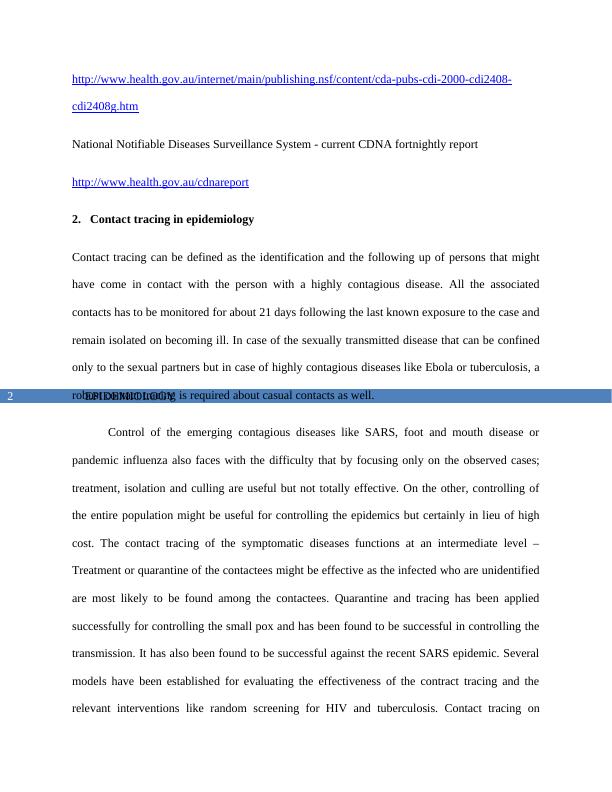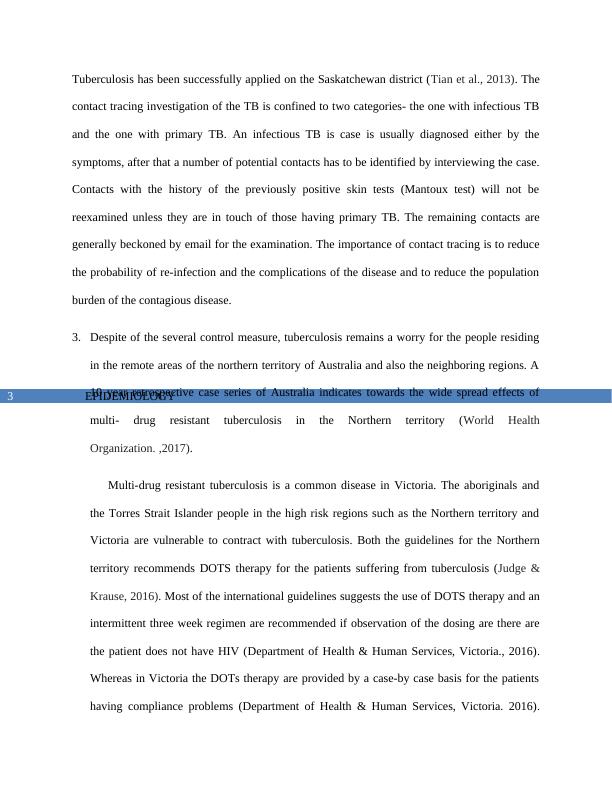PUBH621 - Epidemiology PDF
Added on 2021-11-12
13 Pages3388 Words47 Views
Running head: EPIDEMIOLOGY
EPIDEMIOLOGY
Name of the Student
Name of the university
Author’s note
EPIDEMIOLOGY
Name of the Student
Name of the university
Author’s note

EPIDEMIOLOGY1
1. Notifiable diseases in Australia
Notifiable diseases that are required to be reported to the government by the law. The
collation of the information about the occurrence of the notifiable diseases allows the
government authorities to monitor the diseases such that early warnings for the possible
outbreaks can be given and immediate responses can be taken for the possible outbreaks
(Australian government, Department of health, 2017). Some of the notifiable diseases in
Australia in the year 2018 are avian influenza in humans, campylobacteriosis, Brucellosis,
Dengue virus, diphtheria and more. As per the National Communicable diseases surveillance
report infectious syphilis has been reported as the recent notifiable disease occurring in the
Torres Strait Islander people staying in the northern and the central Australia and has been found
to be increasing at an alarming rate among the men who have sex with men in the urban regions
of Victoria and New south Wales (Australian government, Department of health, 2017). Since
July 2018, the indicators for the person to person transmission of the influenza like illness has
continued to increase making it one of the significant notifiable disease. The rates of shigellosis
in Australia is higher among the Aboriginals and the Torres Strait Islander people in comparison
to the non-aboriginal people. Tuberculosis is also considered as one of the most important
notifiable disease in Australia. This is because the notifications of Tuberculosis over 365 days
surveillance period is around 10% higher compared to the average five years mean. Although the
majority of the TB cases in Australia has been reported to have been obtained by overseas
travelling.
Links of the Australian websites
1. Notifiable diseases in Australia
Notifiable diseases that are required to be reported to the government by the law. The
collation of the information about the occurrence of the notifiable diseases allows the
government authorities to monitor the diseases such that early warnings for the possible
outbreaks can be given and immediate responses can be taken for the possible outbreaks
(Australian government, Department of health, 2017). Some of the notifiable diseases in
Australia in the year 2018 are avian influenza in humans, campylobacteriosis, Brucellosis,
Dengue virus, diphtheria and more. As per the National Communicable diseases surveillance
report infectious syphilis has been reported as the recent notifiable disease occurring in the
Torres Strait Islander people staying in the northern and the central Australia and has been found
to be increasing at an alarming rate among the men who have sex with men in the urban regions
of Victoria and New south Wales (Australian government, Department of health, 2017). Since
July 2018, the indicators for the person to person transmission of the influenza like illness has
continued to increase making it one of the significant notifiable disease. The rates of shigellosis
in Australia is higher among the Aboriginals and the Torres Strait Islander people in comparison
to the non-aboriginal people. Tuberculosis is also considered as one of the most important
notifiable disease in Australia. This is because the notifications of Tuberculosis over 365 days
surveillance period is around 10% higher compared to the average five years mean. Although the
majority of the TB cases in Australia has been reported to have been obtained by overseas
travelling.
Links of the Australian websites

EPIDEMIOLOGY2
http://www.health.gov.au/internet/main/publishing.nsf/content/cda-pubs-cdi-2000-cdi2408-
cdi2408g.htm
National Notifiable Diseases Surveillance System - current CDNA fortnightly report
http://www.health.gov.au/cdnareport
2. Contact tracing in epidemiology
Contact tracing can be defined as the identification and the following up of persons that might
have come in contact with the person with a highly contagious disease. All the associated
contacts has to be monitored for about 21 days following the last known exposure to the case and
remain isolated on becoming ill. In case of the sexually transmitted disease that can be confined
only to the sexual partners but in case of highly contagious diseases like Ebola or tuberculosis, a
robust contact tracing is required about casual contacts as well.
Control of the emerging contagious diseases like SARS, foot and mouth disease or
pandemic influenza also faces with the difficulty that by focusing only on the observed cases;
treatment, isolation and culling are useful but not totally effective. On the other, controlling of
the entire population might be useful for controlling the epidemics but certainly in lieu of high
cost. The contact tracing of the symptomatic diseases functions at an intermediate level –
Treatment or quarantine of the contactees might be effective as the infected who are unidentified
are most likely to be found among the contactees. Quarantine and tracing has been applied
successfully for controlling the small pox and has been found to be successful in controlling the
transmission. It has also been found to be successful against the recent SARS epidemic. Several
models have been established for evaluating the effectiveness of the contract tracing and the
relevant interventions like random screening for HIV and tuberculosis. Contact tracing on
http://www.health.gov.au/internet/main/publishing.nsf/content/cda-pubs-cdi-2000-cdi2408-
cdi2408g.htm
National Notifiable Diseases Surveillance System - current CDNA fortnightly report
http://www.health.gov.au/cdnareport
2. Contact tracing in epidemiology
Contact tracing can be defined as the identification and the following up of persons that might
have come in contact with the person with a highly contagious disease. All the associated
contacts has to be monitored for about 21 days following the last known exposure to the case and
remain isolated on becoming ill. In case of the sexually transmitted disease that can be confined
only to the sexual partners but in case of highly contagious diseases like Ebola or tuberculosis, a
robust contact tracing is required about casual contacts as well.
Control of the emerging contagious diseases like SARS, foot and mouth disease or
pandemic influenza also faces with the difficulty that by focusing only on the observed cases;
treatment, isolation and culling are useful but not totally effective. On the other, controlling of
the entire population might be useful for controlling the epidemics but certainly in lieu of high
cost. The contact tracing of the symptomatic diseases functions at an intermediate level –
Treatment or quarantine of the contactees might be effective as the infected who are unidentified
are most likely to be found among the contactees. Quarantine and tracing has been applied
successfully for controlling the small pox and has been found to be successful in controlling the
transmission. It has also been found to be successful against the recent SARS epidemic. Several
models have been established for evaluating the effectiveness of the contract tracing and the
relevant interventions like random screening for HIV and tuberculosis. Contact tracing on

EPIDEMIOLOGY3
Tuberculosis has been successfully applied on the Saskatchewan district (Tian et al., 2013). The
contact tracing investigation of the TB is confined to two categories- the one with infectious TB
and the one with primary TB. An infectious TB is case is usually diagnosed either by the
symptoms, after that a number of potential contacts has to be identified by interviewing the case.
Contacts with the history of the previously positive skin tests (Mantoux test) will not be
reexamined unless they are in touch of those having primary TB. The remaining contacts are
generally beckoned by email for the examination. The importance of contact tracing is to reduce
the probability of re-infection and the complications of the disease and to reduce the population
burden of the contagious disease.
3. Despite of the several control measure, tuberculosis remains a worry for the people residing
in the remote areas of the northern territory of Australia and also the neighboring regions. A
10 year retrospective case series of Australia indicates towards the wide spread effects of
multi- drug resistant tuberculosis in the Northern territory (World Health
Organization. ,2017).
Multi-drug resistant tuberculosis is a common disease in Victoria. The aboriginals and
the Torres Strait Islander people in the high risk regions such as the Northern territory and
Victoria are vulnerable to contract with tuberculosis. Both the guidelines for the Northern
territory recommends DOTS therapy for the patients suffering from tuberculosis (Judge &
Krause, 2016). Most of the international guidelines suggests the use of DOTS therapy and an
intermittent three week regimen are recommended if observation of the dosing are there are
the patient does not have HIV (Department of Health & Human Services, Victoria., 2016).
Whereas in Victoria the DOTs therapy are provided by a case-by case basis for the patients
having compliance problems (Department of Health & Human Services, Victoria. 2016).
Tuberculosis has been successfully applied on the Saskatchewan district (Tian et al., 2013). The
contact tracing investigation of the TB is confined to two categories- the one with infectious TB
and the one with primary TB. An infectious TB is case is usually diagnosed either by the
symptoms, after that a number of potential contacts has to be identified by interviewing the case.
Contacts with the history of the previously positive skin tests (Mantoux test) will not be
reexamined unless they are in touch of those having primary TB. The remaining contacts are
generally beckoned by email for the examination. The importance of contact tracing is to reduce
the probability of re-infection and the complications of the disease and to reduce the population
burden of the contagious disease.
3. Despite of the several control measure, tuberculosis remains a worry for the people residing
in the remote areas of the northern territory of Australia and also the neighboring regions. A
10 year retrospective case series of Australia indicates towards the wide spread effects of
multi- drug resistant tuberculosis in the Northern territory (World Health
Organization. ,2017).
Multi-drug resistant tuberculosis is a common disease in Victoria. The aboriginals and
the Torres Strait Islander people in the high risk regions such as the Northern territory and
Victoria are vulnerable to contract with tuberculosis. Both the guidelines for the Northern
territory recommends DOTS therapy for the patients suffering from tuberculosis (Judge &
Krause, 2016). Most of the international guidelines suggests the use of DOTS therapy and an
intermittent three week regimen are recommended if observation of the dosing are there are
the patient does not have HIV (Department of Health & Human Services, Victoria., 2016).
Whereas in Victoria the DOTs therapy are provided by a case-by case basis for the patients
having compliance problems (Department of Health & Human Services, Victoria. 2016).

End of preview
Want to access all the pages? Upload your documents or become a member.
Related Documents
Epidemiology of Notifiable Diseases, Contact Tracing and Tuberculosis in Australialg...
|13
|3426
|345
Epidemiology Assignment on Tuberculosislg...
|16
|4620
|210
Epidemiology- Assignment Samplelg...
|10
|3313
|302
Epidemiology cornerstone of public health Assignmentlg...
|11
|3016
|126
Syphilis Outbreak Among Aboriginal and Torres Strait Islanderslg...
|4
|575
|78
High Rates of Sexually Transmitted Infections in Remote Parts of Australia: A Briefing Paperlg...
|14
|3794
|254